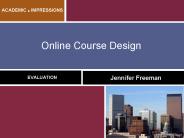Formative Evaluation Using Student Focus Groups - PowerPoint PPT Presentation
1 / 23
Title:
Formative Evaluation Using Student Focus Groups
Description:
Formative Evaluation Using Student Focus Groups Heidi M. Anderson, Ph.D. University of Kentucky College of Pharmacy (UKCOP) Student Focus Groups UKCOP uses student ... – PowerPoint PPT presentation
Number of Views:90
Avg rating:3.0/5.0
Title: Formative Evaluation Using Student Focus Groups
1
Formative Evaluation UsingStudent Focus Groups
- Heidi M. Anderson, Ph.D.
- University of Kentucky
- College of Pharmacy (UKCOP)
2
Student Focus Groups
- UKCOP uses student focus groups as part of the
formative curricular evaluation process - Goals
- Systematic method to collect information about
the curriculum - Assure confidential timely exchange between
professors and students on their perceptions of
course in progress
3
How it Developed
- D. Joseph Clark, Washington University
- Small Group Instructional Diagnosis (SGID)
- 5-step process
- Conducted once mid-semester
- Adapted a hybrid version of SGID
- Student Liaison Committee (SLC)
4
Who Participates in SLC?
- 10 Students from each class for Fall/Spring
- 9 members randomly selected from the 10 small
groups - 1 member is the class Vice President
- Facilitators from the Office of Education
Innovation (OEI) - Assistant Dean
- Assessment Coordinator
- Recorder
- Faculty observers periodically invited
5
Obtaining the Participants
- Beginning of Fall semester students receive 1st
electronic correspondence, that - Explains purpose of Student Liaison Committee
(SLC) - Describes the random selection process
- 2nd correspondence, is sent
- Those 10 selected members, informed of dates,
training, etc. - Entire class announcing the 10 individuals
6
Initial Training Meeting
- Training on Providing Feedback
- Purpose UKCOP process and assessment
- Focus group methodology
- Guidelines on offering constructive feedback
- Relevant and Appropriate
- Specific descriptions
- Offer both positive and negative
- Explain how to improve
7
Meeting Process
- After each set of block exams the Student Liaison
Committee meets to review the learning in each
course - Block Exams approximately every 3 wk period
- Each course is given 10-12 minutes for discussion
- PY1 (7) PY2 (5) PY3 (3)
- SLC members represent their entire class
- Solicit feedback prior to meetings
8
During the Meeting
- Use a systematic 3-question format
- Responses are discussed, consensus is reached and
recorded - Data is organized into a report for the
instructor - Report is sent electronically to the instructor
and course coordinator 48 hours post meeting
9
Feedback Questions
- What elements in the course helped students learn
the material in this course? - What elements in this course hindered the
learning? - What specific suggestions do you have to improve
the course?
10
Post Meeting
- The instructor takes a few minutes of subsequent
class to respond to student feedback in the SLC
report and to describe any changes that will
occur to improve learning - Facilitator will arrange a follow-up session with
the instructor prn
11
Evaluation of SLC Process
12
Evaluation of SLC
- Spring 2005, conducted a survey to determine
student perceptions about SLC - Purpose
- Comfort providing input
- Effectiveness of process
- Accuracy of process
- Benefits
- Areas for improvement
- Specific questions for the SLC members
13
Survey Response Rate
- All 3 classes combined 85
- PY1 90
- PY2 80
- PY3 85
14
I understand the purpose of the SLC
Mean
SD1 D2 A3 SA4
15
I feel comfortable providing information to the
SLC member(s) for discussion at the next SLC
meeting
Mean
SD1 D2 A3 SA4
16
The SLC is an effective way to communicate class
perceptions to faculty and administration
Mean
SD1 D2 A3 SA4
17
The SLC accurately reflects the perceptions of
the entire class
Mean
SD1 D2 A3 SA4
18
As a member of the SLC, the time required to
participate was worthwhile
Mean
SD1 D2 A3 SA4
19
As a member of the SLC, I understood what was
expected of me.
Mean
SD1 D2 A3 SA4
20
Benefits
- Opportunity to voice class opinions to
communicate concerns to faculty - The faculty response to the SLC feedback
21
Areas for Improvement
- Feedback gathered from students by their SLC
members before the meetings - Concern about selecting their own members to the
SLC - Feedback from SLC members about the meeting
22
Suggestions
- More effective methods to obtain student input
before these meetings - Class announcement
- Form
- Summary of the meeting results to the class
23
References
- Clark, J and Redmond, M. Small Group
Instructional Diagnosis Final Report. Settle
Department of Biology Education, University of
Washington, 1982. (ED 217-954). - Coffman, SJ Improving Your teaching Through
Small-Group Diagnosis. College Teaching, 1991,
39(2), 80-82. - Angelo, TA., and Cross, KP. Classroom Assessment
Techniques A Handbook for College Teachers. San
Francisco CA. Jossey-Bass, 1993. - Wimer, M. Improving College Teaching Strategies
for Developing Instructional Effectiveness. San
Francisco CA. Jossey-Bass, 1990.































